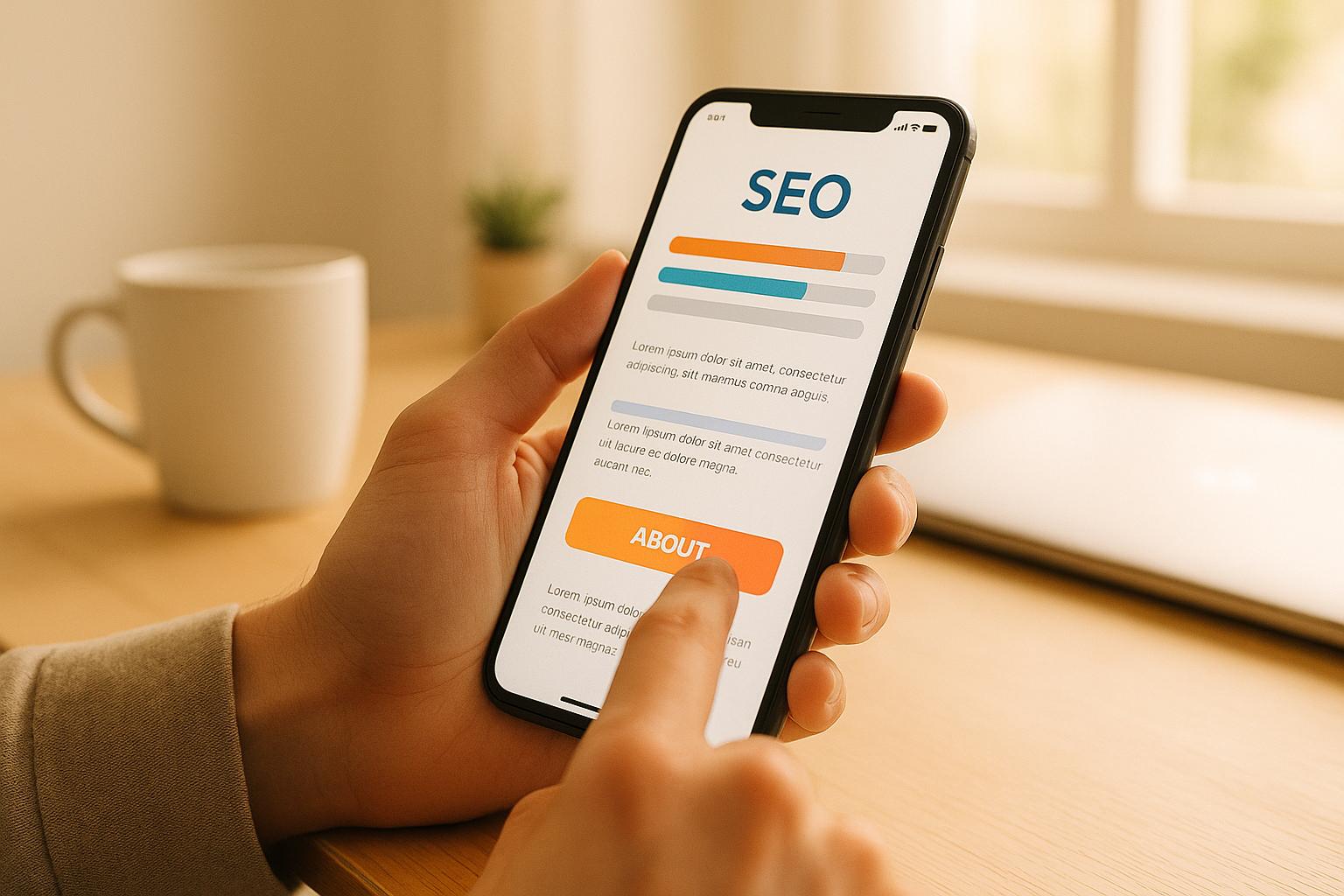With over 64% of global web traffic coming from mobile devices, optimizing your site for touchscreen usability is no longer optional. Poor mobile experiences – like hard-to-tap buttons or slow load times – can frustrate users and hurt your search rankings. Google’s mobile-first indexing means your mobile site performance directly impacts how you rank across all devices.
Here’s what you need to focus on:
- Thumb-friendly design: Place key actions in easy-to-reach areas and ensure buttons are at least 48 pixels wide.
- Touch target spacing: Avoid accidental taps by keeping interactive elements at least 32 pixels apart.
- Readable content: Use fonts of at least 16px, short paragraphs, and clear headings for better readability.
- Fast loading speeds: 90% of users abandon sites that take more than 5 seconds to load.
- Intuitive navigation: Use simple menus, clear labels, and avoid hover-based features.
Optimizing for touchscreen devices not only improves user experience but also boosts engagement, lowers bounce rates, and increases conversions – all critical factors for SEO. By addressing these areas, you’ll stay competitive in a mobile-first world.
How I Optimize SEO for Mobile
Creating Thumb-Friendly and Accessible Interfaces
Designing interfaces for seamless thumb navigation starts with understanding how people actually hold and use their phones. With 49% of smartphone users operating their devices with one hand and 75% of interactions driven by thumbs, making layouts thumb-friendly isn’t just a nice touch – it aligns with real user behavior.
Thumb-Friendly Layout Design
The foundation of thumb-friendly design lies in the "thumb zone", which represents the natural arc your thumb creates while holding a phone. This concept divides the screen into three areas: easy-to-reach, stretch, and hard-to-reach zones.
Bottom navigation has become the go-to standard for mobile interfaces because it places key controls where thumbs naturally rest. Consider Instagram: its navigation bar at the bottom gives users quick access to Home, Search, Reels, and Profile. Similarly, WhatsApp simplifies interactions with a floating "New Chat" button and swipe gestures for calls and attachments. Google Maps also gets it right, keeping search bars, navigation options, and shortcuts within easy reach through bottom sheet interactions and well-placed controls like zoom and direction buttons.
To create a thumb-friendly layout, prioritize placing essential actions in the bottom third of the screen where thumbs naturally rest. Use the upper areas for less critical information. Once the layout is set, ensure precise touch target sizing to improve tap accuracy.
Touch Target Size and Spacing Guidelines
Accurate taps depend on properly sized touch targets. Ideally, interactive elements should measure at least 48 CSS pixels square, though 44×44 pixels is often considered a safe minimum. Why? The average fingertip measures between 0.6 and 0.8 inches wide, while the thumb’s impact area is closer to 1 inch.
Spacing between targets is equally crucial. Google recommends maintaining at least 32 CSS pixels (roughly 0.2 inches) between smaller targets to prevent accidental taps. For smaller elements under 24×24 CSS pixels, ensure there’s enough spacing so a 24 CSS pixel diameter circle centered on one target doesn’t overlap with another. Additionally, targets near the top or bottom of the screen should have extra padding – about 0.43–0.47 inches – compared to those in the center, which can have around 0.28 inches of padding.
Here’s how optimization impacts user experience:
| Aspect | Before Optimization | After Optimization |
|---|---|---|
| User Experience | Frustrating due to accidental taps | Smooth and intentional navigation |
| Page Interaction | High bounce rate from mis-taps | Increased engagement and lower bounce rates |
| SEO Performance | Lower rankings from poor mobile usability | Better rankings with improved mobile experience |
| Maintenance | Frequent user complaints and adjustments | Streamlined interface with fewer tweaks needed |
Accessibility Design Requirements
Beyond thumb-friendly layouts, accessibility ensures that all users, including those with motor challenges, can interact with your site effectively. Following WCAG 2.1 AAA guidelines, interactive targets should be at least 44×44 pixels – except when embedded within text blocks.
High color contrast is critical for differentiating actionable items, especially in bright sunlight or low-light conditions. Text readability also matters: body text should be at least 15–16 pixels, while buttons and other interactive elements should feature larger, bold text to clearly signal their purpose.
Generous touch targets and proper spacing not only improve usability for users with motor limitations but also enhance the overall mobile experience. This inclusive approach leads to better engagement, which can indirectly boost SEO performance.
Simplifying Navigation for Touch Devices
When designing for touch devices, creating intuitive navigation is crucial for both user engagement and SEO performance. Unlike desktop interfaces where users can hover over elements for previews, touchscreens require immediate clarity and straightforward interactions. The goal is to make menus and gestures feel natural and predictable, ensuring users can find what they need with minimal effort.
Simple Menu Design
For mobile menus, functionality should always take precedence over flashy visuals. Position navigation elements where users expect them – either at the top or bottom of the screen – and consider using sticky menus on longer pages to keep navigation easily accessible.
The hamburger menu is a reliable option for mobile interfaces when implemented thoughtfully. Limit the number of main navigation items to avoid overwhelming users. A concise, streamlined menu reduces decision fatigue and makes navigation more intuitive.
Submenus should include clear indicators, like arrows, to show they contain expandable content. These should activate with a tap, not a hover, to ensure consistent functionality on touch devices.
Additionally, menu links need to be large enough for easy tapping, but size alone isn’t enough. Proper spacing between items is just as important. Avoid cramming too many options into a single row and ensure there’s enough room between clickable elements to prevent accidental taps.
"Prioritize functionality over decorative effects should not be one of your priorities when creating menus… users tend to be far more impressed by great content that is attractively presented and easily accessed with familiar menus." – Page Laubheimer
Clear Labels and Standard Icons
Clear, straightforward labels play a key role in simplifying navigation. Avoid using overly creative or ambiguous terms that might confuse users. For instance, stick with familiar labels like "About Us" instead of "Our Story" or "Contact" instead of "Connect." These standard terms make it easier for users to navigate without hesitation.
Icons can enhance navigation, but they should complement text labels rather than replace them. Use universally recognized symbols, such as a house for the home page, a magnifying glass for search, or three horizontal lines for a menu. Ensure these icons are large enough for accurate tapping and maintain consistent styling throughout the interface.
Pairing descriptive text with standard icons creates a navigation experience that’s both user-friendly and SEO-friendly.
Replacing Hover-Based Features
Since hover effects don’t work on touchscreens, replace hover-dependent dropdown menus with tap-to-expand options. This adjustment simplifies navigation and ensures users can access content directly without relying on hover actions.
You can also incorporate swipe gestures for common navigation tasks, but always include visible tap alternatives. While swipe gestures can enhance the experience for more advanced users, visible options are essential to ensure accessibility for everyone.
Using Touchscreen Gestures for Better User Experience
Touchscreen gestures have become a cornerstone of mobile interaction, offering users a more natural and intuitive way to navigate digital interfaces. When thoughtfully implemented, these gestures simplify complex interfaces and create an engaging experience, encouraging users to explore your site further.
Common Touchscreen Gestures and Their Applications
Knowing which gestures work best for specific actions is key to designing interfaces that feel intuitive and predictable. Here are some widely used gestures and their ideal use cases:
- Tap: The go-to gesture for selecting items, activating buttons, and triggering actions. To improve usability, consider the "open/activate/select on release" approach, which allows users to cancel an action by moving off the button before releasing.
- Double-tap: Perfect for zooming in or centering content like images, maps, or text that requires closer inspection.
- Swipe: A versatile gesture for navigation and scrolling. Horizontal swipes are great for switching between pages or sections, while vertical swipes work well for scrolling through content or revealing hidden options. Swipes can also streamline actions like deleting or archiving items.
- Pinch to Zoom: Essential for zooming in and out on images, documents, or graphics.
- Long Press: This gesture is ideal for accessing secondary actions or menus, keeping the interface clean and uncluttered.
| Action | Best Gesture | Primary Use Case |
|---|---|---|
| Select an item | Tap | Buttons, links, menu items |
| Navigate between pages | Horizontal swipe | Image galleries, article sections |
| Scroll through content | Vertical swipe | Long articles, product lists |
| Zoom content | Pinch to zoom | Images, maps, detailed graphics |
| Access secondary options | Long press | Context menus, advanced settings |
By following these guidelines, you can design interfaces that feel intuitive while providing responsive feedback to users.
Visual Feedback and User Guidance
Touchscreens lack the tactile feedback of physical buttons, making visual feedback crucial for user confidence. Quick visual responses – preferably within 100 milliseconds – help users know their actions have been registered. For example, changing a button’s appearance (such as color or size) when tapped offers immediate confirmation.
Animations can also guide users through gesture-based interactions. Subtle visual cues, like showing the edge of a card to suggest it can be swiped, or animating elements to hint at their functions, make interfaces easier to navigate. Real-time animations that respond to gestures create a sense of direct control, while shadows, highlights, or familiar icons indicate which elements are interactive, reducing confusion.
How Gestures Impact SEO Performance
Intuitive gestures don’t just enhance the user experience – they can also improve your site’s performance and SEO. By simplifying interactions, gestures reduce interface complexity, which can lead to faster page loads and more efficient server use, both of which contribute to better SEO rankings.
When users can effortlessly swipe, scroll, or zoom, they’re more likely to spend time exploring your content. This increased engagement sends positive signals to search engines, potentially lowering bounce rates. Features like pull-to-refresh for content updates not only improve interaction speeds but also minimize server load by avoiding unnecessary page reloads. Consistent gesture-based design, paired with clear visual feedback, ensures an experience that benefits both users and search engines.
sbb-itb-880d5b6
Making Content Easy to Read and Use on Mobile
Creating content that works well on mobile devices means focusing on what matters most and presenting it in a way that’s easy to digest. Mobile users tend to skim, so your content needs to deliver key information fast.
Organizing Content for Mobile Screens
Start with a clean, single-column layout. Keep paragraphs short – three to four sentences max – and use bullet points and clear headings to break up the text. Each paragraph should focus on just one idea to make things easier to follow.
Since mobile screens have limited space, structuring your content is crucial. Use headings, subheadings, and white space to guide readers through your material. For instance, the BBC News website uses a responsive design that adjusts seamlessly to different screen sizes, ensuring content is always presented in the best possible way.
These design choices help make your content more readable and engaging for mobile users.
Design Choices That Improve Readability
Good typography can make or break the mobile experience. Use a font size of at least 16px for body text, with line spacing between 140% and 180%, and keep line lengths to 45–90 characters. This not only improves readability but also prevents iOS browsers from zooming in unnecessarily when users tap text input fields.
"Line spacing is an important part of typography and the usability and readability of your site or app. By applying these simple rules, you can reduce user tiredness, boost clarity and improve your content’s accessibility rating." – Rebeka Costa, In-house SEO manager, usability enthusiast
Use relative units like "em" or "rem" for text sizing so users can adjust text size based on their preferences. High-contrast color combinations are also essential to ensure readability in varying lighting conditions and device settings. Always test your designs on real mobile devices – not just in desktop browsers – to confirm that font sizes, spacing, and layout work as intended.
By improving readability, you’re not just helping general users – you’re also making sure local businesses can connect with their audience quickly and effectively.
Mobile Features for Local Businesses
Local businesses can benefit greatly from mobile-specific features that boost usability and engagement. For example, include click-to-call buttons prominently on contact or service pages so users can reach you with a single tap. Interactive maps with touch gestures like pinch-to-zoom and tap-for-details make it easier for users to find your business and get directions.
Make sure your business shows up in "near me" searches by optimizing mobile-friendly landing pages. These pages should load quickly and include essential details like your location, hours, contact info, and services.
You can also use location-based marketing to send personalized offers via GPS. SMS marketing is another powerful tool – text messages have a 98% open rate, and 60% of emails are opened on mobile devices. When running SMS campaigns, ensure the links direct users to mobile-optimized landing pages for a smooth experience.
Comparison Table: Touchscreen Features and SEO Benefits
This table highlights how specific touchscreen features directly influence SEO performance. By focusing on user-friendly design, you can improve engagement, extend dwell time, and ultimately enhance your site’s rankings.
Usability Features vs. SEO Benefits
The connection between touchscreen usability and SEO is simpler than it seems. When mobile users can effortlessly navigate your site, they tend to stay longer, interact more, and convert at higher rates – key signals search engines consider for rankings.
| Touchscreen Feature | SEO Benefit | User Impact | Technical Requirement |
|---|---|---|---|
| Thumb-Friendly Buttons (48+ pixels) | Reduces bounce rate, boosts time on page | Minimizes accidental clicks and frustration | Buttons at least 48 pixels with proper viewport settings |
| Adequate Touch Target Spacing (32+ pixels apart) | Improves satisfaction, lowers exit rates | Prevents mis-taps and navigation errors | Minimum 32 pixels spacing (horizontal and vertical) |
| Sticky Navigation | Increases engagement and page views | Keeps menus accessible throughout scrolling | Use CSS position: sticky with mobile-first design |
| Readable Font Sizes (16+ pixels) | Reduces bounce rate, extends session duration | Removes the need for pinch-to-zoom | Body text at least 16px using relative units |
| Visual Feedback for Taps | Enhances usability, boosts conversions | Provides confirmation for user actions | Add clear visual cues for all interactive elements |
| Gesture Support (swipe, pinch) | Improves engagement and page views | Matches natural interaction patterns | Implement touch event handling and gesture recognition |
| Fast Loading Interactive Elements | Improves Core Web Vitals scores | Reduces delays in touch responses | Optimize JavaScript and streamline event handling |
| Mobile-Optimized Forms | Increases conversions, reduces abandonment | Simplifies data entry on small screens | Use large fields with proper spacing |
Every feature listed here addresses a specific usability challenge while delivering measurable SEO benefits. With mobile traffic dominating web usage and users quick to abandon poorly designed sites, optimizing for touchscreens is a must for maintaining search visibility.
"Mobile-first indexing means Google uses the mobile version of your website as the primary basis for indexing and ranking rather than the desktop version." – Julia McCoy, Search Engine Land
Mobile optimization isn’t just a technical detail – it’s a core part of staying competitive in SEO. Since mobile eCommerce now accounts for nearly 73% of the global market, touch-friendly design is no longer optional. These adjustments ensure your site meets user expectations while improving your search rankings.
Conclusion: Balancing Usability and SEO Performance
Improving touchscreen usability isn’t just about making your site easier to navigate – it’s a direct boost to your mobile SEO performance. With mobile devices now accounting for over 54% of global web traffic and projections showing that more than 75% of eCommerce sales will come from mobile by 2025, mobile optimization is no longer optional. It’s essential for staying competitive.
When your site works seamlessly on phones and tablets, users stick around longer, engage more deeply, and are more likely to convert. These behaviors send strong positive signals to search engines, which can improve your rankings. Google’s mobile-first indexing underscores this connection, as it evaluates and ranks sites based on their mobile performance.
"Mobile SEO is no longer an optional strategy, but rather a necessity for businesses that want to remain competitive in an increasingly mobile-centric world." – Straight North
The numbers don’t lie: businesses with mobile-optimized sites are three times more likely to see a jump in mobile conversion rates. This shows that prioritizing usability isn’t just about search rankings – it’s a critical driver of overall business success.
Optimizing for touchscreen usability isn’t a one-and-done task. It’s an ongoing effort that works hand-in-hand with technical SEO.
Why Technical SEO Audits Matter
Regular technical SEO audits are a must for identifying and fixing mobile usability issues that affect both user experience and search performance. These audits can uncover problems like slow load times, broken links, and poor mobile responsiveness – issues that frustrate users and hurt your rankings.
"Regular technical SEO audits are vital for maintaining and improving your website’s health and performance." – Alex McInnes, Content Strategist and Digital Marketer, Quickly Hire
Key areas covered in these audits include crawlability, site speed, mobile-friendliness, and structured data. When these technical elements are in good shape, users can easily navigate your site, and search engines can properly index your content.
For businesses looking to take their mobile optimization to the next level, services like SearchX’s technical SEO audits offer tailored solutions. These comprehensive reviews address critical issues, ensuring your site meets technical standards while delivering a smooth mobile experience that keeps users engaged.
After an audit, ongoing monitoring is essential to maintain peak performance and adapt to changes.
Continuous Testing and Improvement
Mobile optimization is a continuous process. As user behavior shifts, new devices hit the market, and search algorithms evolve, regular testing and updates are crucial to staying ahead.
Start with tools like Google Search Console to identify mobile usability errors and indexing problems. Google’s Mobile-Friendly Test and PageSpeed Insights are also great for assessing your site’s mobile performance baseline. These free tools can quickly highlight areas that need attention.
For deeper insights, go beyond basic testing. Regularly monitor Core Web Vitals to track critical metrics like loading speed, interactivity, and visual stability on mobile devices. Heatmaps and session recordings can also provide valuable data on how real users interact with your site.
Consider this: 61% of users are unlikely to return to a site they had trouble accessing on mobile. Proactive testing can help you identify and resolve problems before they drive users away. Focus on responsive design, fast loading times, and seamless usability to keep both users and search engines happy.
While the mobile landscape will keep evolving, one thing is clear: websites that cater to touchscreen users consistently perform better in search results. By committing to regular audits, testing, and improvements, you’ll maintain your edge in an increasingly mobile-first world.
FAQs
How does improving touchscreen usability benefit SEO?
Enhancing how users interact with touchscreens can play a big role in improving your SEO. Why? Because search engines reward websites that offer a seamless experience for mobile users. This means incorporating touch-friendly features like buttons and links that are easy to tap without accidental clicks. When users can navigate without frustration, they’re less likely to leave your site, which helps reduce bounce rates.
On top of that, making sure your site is mobile-responsive and loads quickly is essential. A fast, responsive site not only improves usability but also boosts your search engine rankings. Together, these elements lead to happier users and better engagement – both of which are key for SEO success.
What are the key design tips for making a website easy to use with your thumb?
When designing a website that’s easy to navigate on mobile devices, prioritize larger touch targets – aim for at least 48 pixels wide. Space them about 32 pixels apart to minimize accidental taps and improve overall usability.
Place essential interactive elements, like buttons and menus, in the natural thumb zone, which is typically in the lower half of the screen. This makes them more accessible and convenient for users.
Also, consider one-handed use by keeping navigation and key controls within the thumb’s comfortable reach. These thoughtful tweaks can make a big difference in creating a smoother, more engaging mobile experience.
Why are regular technical SEO audits essential for improving mobile usability?
Regular Technical SEO Audits for Mobile Optimization
Keeping your website in top shape for mobile users means conducting regular technical SEO audits. These audits are your chance to spot and fix problems like mobile responsiveness, loading speed, and user experience – all key factors that influence how your site ranks in search engines.
A mobile-friendly site doesn’t just help with rankings. It can also lower bounce rates, make navigation smoother, and ensure your site aligns with search engines’ emphasis on mobile usability. Staying ahead like this keeps your site competitive and ensures it’s always ready for users on-the-go.




